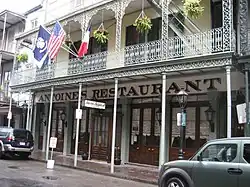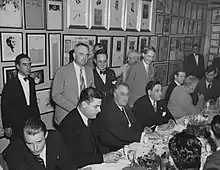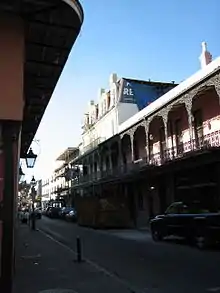Antoine's
Antoine's is a Louisiana Creole cuisine restaurant located at 713 rue St. Louis (St. Louis Street) in the French Quarter of New Orleans, Louisiana. It is one of the oldest family-run restaurants in the United States, having been established in 1840 by Antoine Alciatore.[2] A New Orleans institution, it is notable for being the birthplace of several famous dishes, such as Oysters Rockefeller,[3] pompano en papillote, Eggs Sardou and Pigeonneaux Paradis. Antoine's Cookbook, compiled by Roy F. Guste (the fifth-generation proprietor) features hundreds of recipes from the Antoine's tradition. It is also known for its VIP patrons including several U.S. presidents and Pope John Paul II.
| Antoine's | |
|---|---|
 Antoine's Restaurant, October 2007 | |
| Restaurant information | |
| Established | 3 April 1840[1] |
| Food type | Louisiana Creole cuisine |
| Street address | 713 Rue St. Louis (St. Louis Street) |
| City | New Orleans |
| State | Louisiana |
| Country | United States |
| Coordinates | 29.9567°N 90.0666°W |
| Website | Antoine's official website |
Antoine's features a 25,000 bottle capacity wine storage and 15 dining rooms of varying sizes and themes, with several featuring Mardi Gras krewe memorabilia. The lengthy menu (originally only in French, now in French and English) features classic French-Creole dishes. By tradition, it's closed to the general public on Thanksgiving, Christmas, and Mardi Gras. It can be reserved for private parties on these "Closed Days". Advance reservations are required for dining during Mardi Gras and on weekends. The executive chef as of March 2020 is Rich Lee.
Ownership and management
| Management[4] | Date |
|---|---|
| Antoine Alciatore | 1840–1875 |
| Julie Freyss Alciatore | 1875–1887 |
| Jules Alciatore | 1887–1934 |
| Roy Alciatore | 1934–1972 |
| William J. Guste and Roy Guste | 1972–1975 |
| Roy Guste Jr. | 1975–1984 |
| Bernard “Randy” Guste | 1985–2004 |
| Rick Blount | 2005–present |
Antoine's was founded by Antoine Alciatore in 1840 and run by him until 1875. After his death at the age of 55, Julie Freyss Alciatore, his wife, took over while their son Jules Alciatore got culinary training in France. Upon his return in 1887, he took control of the restaurant until 1934. During this time, Jules also acquired property around the original restaurant as it became available, including a former slave quarters and carriage house. Antoine's eventually could accommodate 800 people in its 15 dining rooms. Each dining room was decorated according to a theme, many of the themes referencing a Mardi Gras krewe, such as Rex, Proteus, Twelfth Night or Maison Verte.[2] Later, his son, Roy Alciatore, took over until 1972. After Roy's death, William J. Guste and Roy Guste, both Antoine Alciatore's great-grandchildren, took over for a brief three years before appointing Roy Guste Jr., who managed the restaurant until 1984. For the next twenty years, between 1985 and 2004, the restaurant would be managed by Bernard “Randy” Guste, Roy Guste Jr.’s cousin. Rick Blount, son of Yvonne Alciatore Blount who is Roy’s daughter, was brought in as owner and manager in 2005 as an attempt to save the restaurant from a critical economic state. Under his management, the restaurant recovered after Hurricane Katrina. He saw to many renovations in its infrastructure, as well as menu changes and changes in the dining rooms. [4]
Cuisine
The current owner, Rick Blount, describes Antoine's food as "Haute Creole", characterized as innovative and sophisticated Creole cooking with strong French traditions. The restaurant has a non-seasonal à-la-carte menu that features dishes with regional influences such as turtle, pompano, redfish, and shellfish, with preparation techniques that reflect a French aesthetic. Throughout its history and changing menus, Antoine's has had very little Cajun influence, and featured no Italian foods.[4]
Pompano en papillote, a specialty of Louisiana Creole cuisine, was invented at Antoine's.[5]
Unique facilities
Cellars are not practical in New Orleans because the water table is very high. Therefore, Antoine's has what is best described as a "wine alley", a corridor 165 feet (50 m) long, lined by wine racks and carefully air-conditioned. Guests who are present at closing time are sometimes offered a tour of Antoine's, which includes the 15 dining rooms and many display cases full of Antoine's memorabilia.

Café Brûlot
Antoine's is also known for Café Brûlot, a drink made from coffee, orange liqueur, cinnamon stick, sugar, cloves, and lemon peels. At Antoine's, the coffee is customarily flamed when it is served as part of a dessert course.
Trivia
During Prohibition, Antoine's served alcohol in coffee cups that were carried through the ladies' restroom into the Mystery Room, one of the themed dining rooms.[2]
The restaurant closed the Japanese Room at the beginning of World War II. It remained closed for 43 years.[2]
Antoine's requires all aspiring servers to spend two to three years in its apprentice program before they "make waiter".[2]
In media
In the 1951 Bugs Bunny cartoon French Rarebit, a reference to Antoine's plays a pivotal role, as Bugs convinces two Parisian chefs to let him show them how to cook "Louisiana Back-Bay Bayou Bunny Bordelaise", exclusively because it is "a la Antoine". "Antoine of New Orleans?" the first chef asks, awestruck. Bugs retorts, "Well, I sure don't mean Antoine of Flatbush!"
In the film Apocalypse Now, Chef (Frederic Forrest), a character from New Orleans, briefly mentions it.
The book Dinner at Antoine's
Dinner at Antoine's, a 1948 murder mystery by Frances Parkinson Keyes, begins with a dinner party in the 1840 Room and includes another dinner party at Antoine's near the end.[7] Antoine's itself is not pivotal to the plot, which hinges on the murder of a woman from a snobbish-but-impoverished old Creole family, just as she was beginning to face a serious chronic illness. Rather, Antoine's is part of the ambience of New Orleans, which Keyes depicts as an exotic, half-foreign city whose ways are not easily understood by outsiders, especially those from the North. The novel is notable for its use of the "least likely person" motif in revealing the identity of the murderer, and for a final plot twist that renders the murder and its aftermath even more tragic. Antoine's is mentioned in other novels by Keyes, including Once on Esplanade, Crescent Carnival, The River Road, and its sequel, Vail D'Alvery. Dinner at Antoine's was Keyes's best-selling and best-known book.
Appearance in the film JFK
Antoine's was used for the filming of two sequences in Oliver Stone's 1991 movie, JFK. The first, which is quite brief, shows the Garrison family waiting for their father in the mirrored Main Dining Room. In the second, which lasts several minutes, Jim Garrison (played by Kevin Costner) has lunch with his staff in the Large Annex Room. At the beginning of the segment, he is greeted by the real maitre d'hôtel, Henri Alciatore, a direct descendant of the founder.
Hurricane Katrina

The French Quarter was above the flooding that devastated the majority of New Orleans in the aftermath of Hurricane Katrina in 2005 (see: Effects of Hurricane Katrina in New Orleans), but Antoine's suffered from the hurricane winds which damaged part of the roof and knocked down a section of exterior wall. The extensive contents of Antoine's wine cellar were also lost due to a failure in the climate-control system; as of June 2006, the cellar is slowly being replenished, $10,000 per week being devoted to new purchases. The restaurant was able to reopen on December 29, 2005. In the wake of Katrina, Antoine's has added its first-ever Sunday Jazz Brunch program. Two years after Katrina, the restaurant nearly declared bankruptcy due to zero customer base but managed to hold on. It is currently one of the best restaurants in New Orleans in terms of revenue and customer patronage.
Famous dishes
- Oysters Rockefeller
- Pompano en Papillote
- Beef Robespierre
- Toast St. Antoine
- Toast Balthazar
- Pompano Montgolfier
- Filet of Sole Joinville
- Filet of Beef Périgueux
- Bouchées à la Reine
- Becassine sur Canapé
- Oysters Bienville
- Oysters à la Ellis
- Oysters à la Foch
- Tomates à la Jules César
- Sole Marguery
- Trout Meunière
- Eggs Sardou
- Bouillabaisse à la Marseillaise
- Chicken Rochambeau
- Tripes à la mode de Caen
- Onion soup gratinée
- Escargots à la Bordelaise [4]
References
- Todd A. Price. "175 years ago, on April 3, 1840, Antoine's opened for business". Nola.com. Retrieved 3 June 2022.
- Molly Hennessy-Fiske. "Antoine's is her family legacy, but is she ready?". The Los Angeles Times. Retrieved 10 May 2013.
- Bryce Crawford. "Local outfits battle for hot wing supremacy". Colorado Springs Independent. Retrieved 13 April 2010.
- Freedman, Paul. "Antoine's Haute Creole". Ten Restaurants That Changed America. New York: Liveright Corporation, 2016. N. pag. Print.
- "Antoine's Restaurant". Atlas Obscura. Retrieved 2020-12-31.
- "1937 - FDR in New Orleans". Pontchartrain.net.
- "Book Reviews, Sites, Romance, Fantasy, Fiction". Kirkus Reviews. Retrieved 2023-04-17.
External links
![]() Media related to Antoine's Restaurant at Wikimedia Commons
Media related to Antoine's Restaurant at Wikimedia Commons